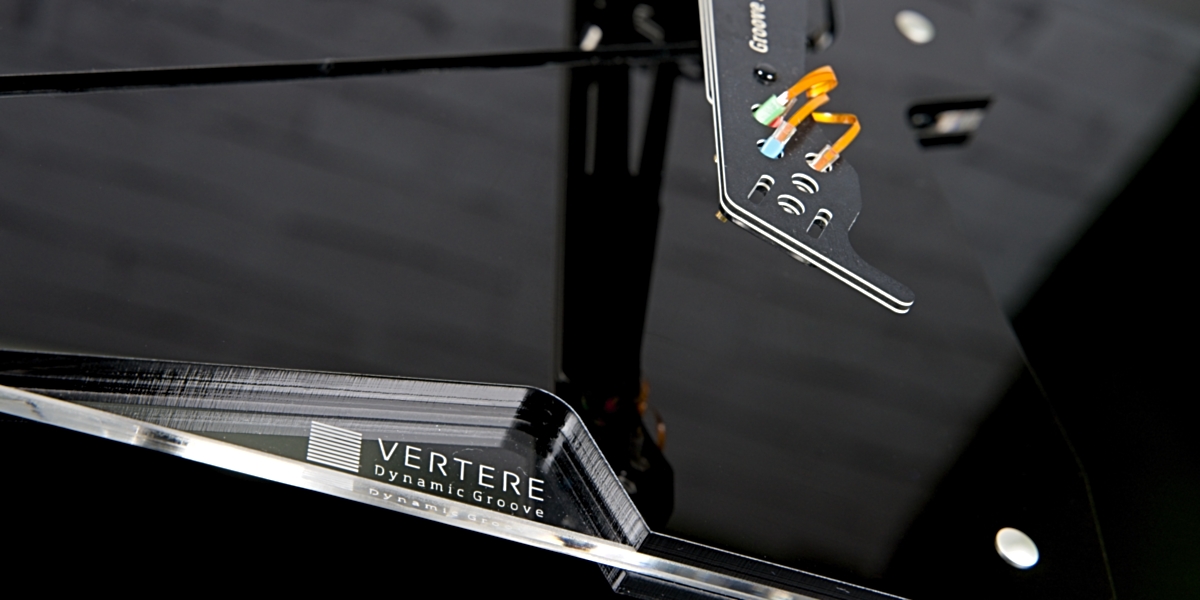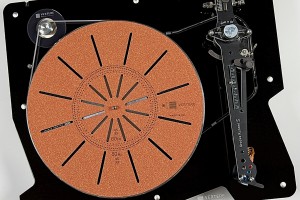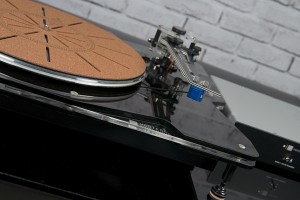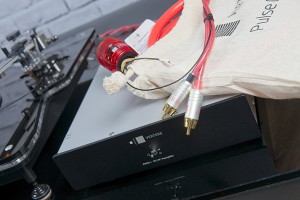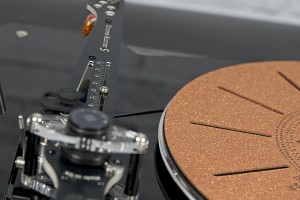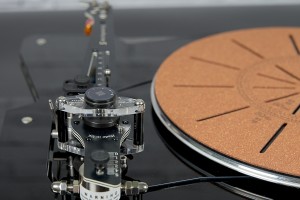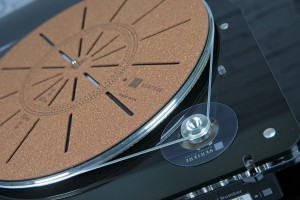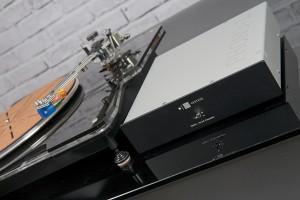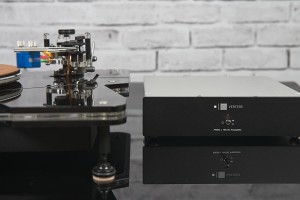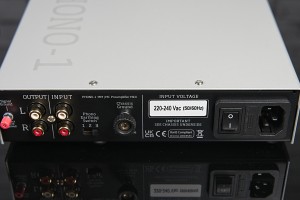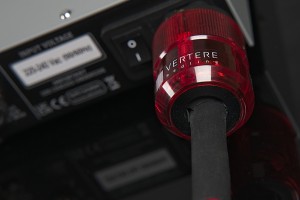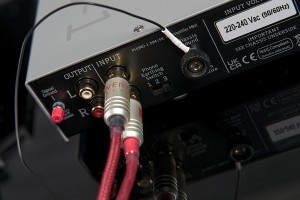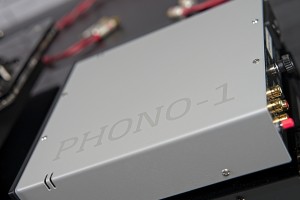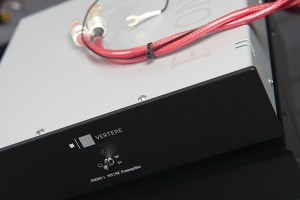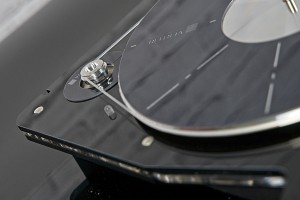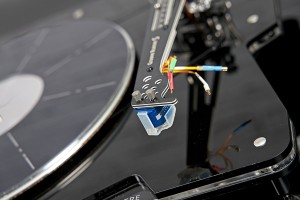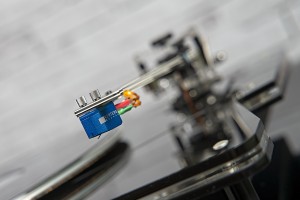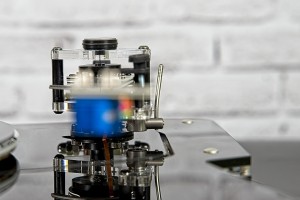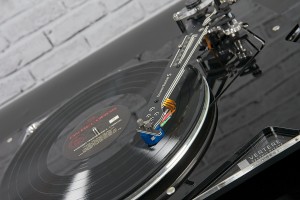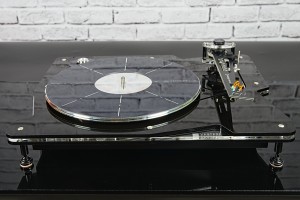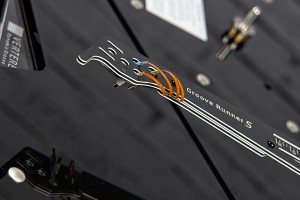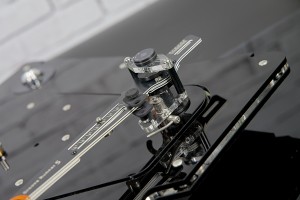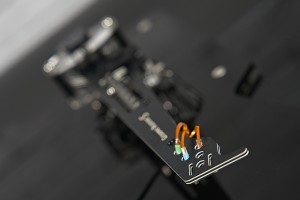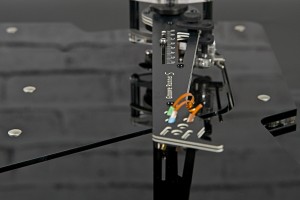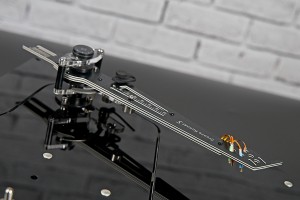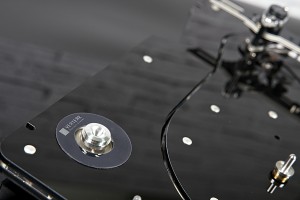Some turntable manufacturers only start their lineup where others end theirs. I find one of such cases to be Vertere Acoustics. For this test, they sent me a set including an excellent Vertere DG-1S deck, their top (at the time), MC cartridge, Mystic, and the only phono stage in their lineup named simply Phono-1 MKII. My job is to assess the set and, hopefully, have a lot of fun while doing it.
Introduction
It’s been more than 6 years since my first memorable adventure with a Vertere turntable took place but considering the very positive results of my assessment of the MG-1 + SG1 set (record player + tonearm; you can find it in Polish HERE) I have been looking forward to another one ever since. Luckily, this year at Munich High End Show I met Hari Strukelj, a man responsible for the aforementioned review, and Vertere’s long-time distributor, and he invited me to visit the HiFi Delux Show that every year takes place at the same time as the main event. There, the man behind the British brand, Touraj Moghaddam, presented his turntable together with FM Acoustics electronics and loudspeakers – worthy companions, if you ask me.
When I came to the room it was Touraj who led the presentation and, funny enough, it seemed that he took all the albums he used straight from my record collection. Thus, I could enjoy one familiar track after another, and, importantly, these were not your „traditional” audio show samplers, but rather pieces of „real” music. And it (the setup) sounded good, really good despite not particularly friendly hotel room’s acoustics! It wasn’t much of a surprise for me as most years I find some time to visit this show and FM Acoustics is always there, always setting the performance quality bar quite high. And so it did this year and Vertere’s turntable played its role in it.
After the presentation, we had a chance to chat and we agreed that with Hari’s highly appreciated help, Vertere would deliver a turntable with a tonearm, a cartridge, and a phono stage for a review. The idea was simple – they wanted to give me a chance to get to know several products and to test a complete analog setup prepared by them so that I could explore their philosophy of sound. It took a while to organize but finally, some time ago a couple of boxes arrived at my doorstep from Slovenia (where Hari resides).
For those of you not familiar with Vertere Acoustics’ current lineup let me explain that it includes four record players, three cartridges (before the review could be published they actually introduced yet another pickup), and three tonearms (at least sold separately, because the one used in the tested deck isn’t among them), but also motor drives, lots of analog playback enhancing accessories, and audio and power cables. So just as in the case of this review, one can use the lineup to build an entire analog setup using only Vertere’s products. I know that audiophiles love to experiment and mix things up, but in my experience, once you find brands that offer you a sound you like, the more of their products find a way to one’s rig the better. So if you ever decide to purchase one of Touraj’s decks give his tonearm, cartridges but also cables a chance.
The turntable delivered for this test, DG-1S Dynamic Groove, is the most affordable among them, and the latest version of the highly acclaimed DG-1. It shares some features with its bigger brothers (or sisters – who knows?) and surprises with others. First of all, it does not really look like an „entry-level” product. Same as with any Vertere record player, DG-1S looks really sleek. It features a compact, black (alternatively white), fancy-shaped, acrylic multi-layer chassis and the very unusual flat (also multi-layer) tonearm using thread bearings, both vertical and horizontal.
„Entry-level” in this case doesn’t mean what it usually does, because it is not a cheap product, as depending on the version it will cost you between 4148 and 4448 EUR (without or with tonearm) or more if you buy it as one of the proposed packages with a cartridge, and some accessories. In other words, it’s not a proposal for those who are looking for a highly affordable way to play vinyl records or their first record player ever (unless they plan to start from an already high level) but rather for those, who are looking for a very good performer in an attractive package that still costs less than a car. It is just cheaper than the other Vertere record players but its price suggests it has a lot to offer. How much exactly? My job is to find that out and share my assessment with you. By the way, if you want to learn a bit about the company’s philosophy you can follow this link HERE and watch the people behind the company and its products to explain it themselves.
To clarify, the set I got for the review isn’t actually one of the three standard packages because DG-1S is offered either without any cartridge (Redline Package) or with one of the two Vertere’s Moving Magnet pickups (Magneto Package or Sabre Package). The latter is the most expensive, and the Redline is the mid-priced one. Unless one pairs it with the 3448 EUR Mystic MC pickup that is. So what I actually got for the test, as it seems, is the Redline Package (as it included all the additional accessories – Redline interconnect, Stylus Balance, IsoPaw feet, Techno Mat, but no MM cartridge) plus the most expensive (at the time) in the Vertere’s range Mystic MC pickup and the only phonostage in the lineup, Phono 1 MkII. One more item the review set included was the Redline power cable that I used with Phono-1 MkII.
Design and features
Most of today’s record players still follow the rectangular shape that’s been a standard for decades. If that’s what you like DG-1S (DG stands for Dynamic Groove, by the way) is probably not for you. Yet, if you fancy original, eye-catching designs, you will love it. Same as the original version, one I’ve never had a chance to listen to to be clear (hence I can’t offer a comparison in terms of performance) DG-1S is still not a particularly heavy unsuspended, belt-driven design. Although the pricelist I receive suggests one may order only the deck, if not for other reasons than a small price difference I would suggest buying it with the Vertere’s custom-designed Groove Runner S tonearm.
Vertere, same as many other manufacturers, utilizes the trickle-down method using some of what they learned with the more expensive models in the less expensive ones. Hence the design of the DS-1S is somewhat similar, or a simplified version of the bigger models. Namely, the plinth comprises (three acrylic) layers that are separated with isolating bespoke silicon rubber couplings. The latter’s job is to isolate the design from resonances. The ones in the reviewed version are said to fulfill their role even more effectively.
An important element of the design is a sub-chassis placed within the top plinth. In its center, there is a revised, and improved version of the main bearing with a new, higher-quality polishing arrangement and tighter tolerances. The main bearing is one of the key elements of any turntable and the higher its quality the lower the level of the noise floor which significantly improves the sound we can hear. On top of the main bearing’s shaft, which is made of hardened stainless steel running in a high tolerance casing on a tungsten carbide ball, and lubricated for life, sits a relatively thin platter made of aluminum that also features an integral PETG record mat. As a part of the set I received for this test also came Vertere’s own Techno Mat that should be placed on top of the integral one. It is a composite of cork and polymer layer with a randomly fibrous upper section that creates a sort of air cushion for the record.
The motor is a low voltage precision 24-pole synchronous unit that is digitally controlled with allows you to choose 33 1/3 or 45 r.p.m. speeds with a push of a button. The manufacturer emphasizes a new software that allows separate adjustment in two steps, initially the sine wave voltage and then the cosine wave adjustment at the final stage, for the lowest possible noise and vibration. As standard, DG-1S is delivered with a simple wall-wart PSU but there’s an option of using the Challenger linear PSU offered separately by Vertere.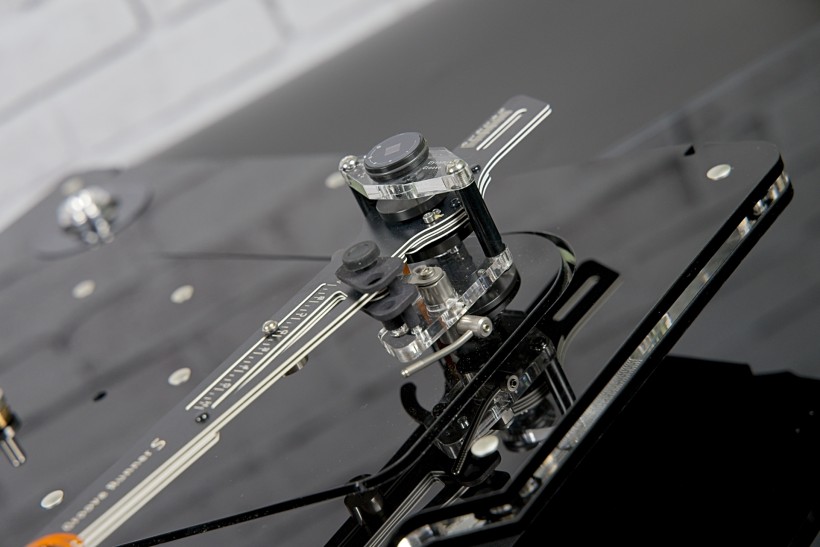
As the manufacturer claims, the 5-ply Groove Runner S, an unusually flat 9-inch tonearm offers much higher acoustic linearity than its predecessor. The Top and Lower beams of the arm are bonded and riveted to ensure optimum rigidity combined with linear resistive damping. Groove Runner S features a thread bearing with one twisted nylon 6.6/6 thread for horizontal motion, and two high-strength Kevlar threads for vertical. The thread bearing is adjustable for tension and azimuth. Adding a new Azimuth Adjustment Counterweight Screw allows for a convenient, and finer azimuth setting. From the user’s perspective all adjustments are easy to use so setting this tonearm up is relatively easy. The internal wiring is of one piece from cartridge to output (RCA sockets) sort and it is terminated with Vertere gold-plated cartridge tags.
When I started this review Mystic Moving Coil cartridge was the top of three models (the other two are MMs – Sabre and Magneto). Since then a new top-of-the-line was introduced, XtraX MC, and also another, most expensive MM pickup named Dark Sabre MM. Let’s focus on the Mystic MC though. It’s a moving coil unit, as already stated, offering an output of 0,5 mV. Recommended VTF is 2g.
Its body is machined from solid Aluminium alloy and mass-tuned to the generator for optimum support and control of unwanted mechanical vibrations. Luckily (from my point of view) the body is threaded and one couples it to the headshell using two supplied stainless steel thumb screws. There are three specifically designed contact points machined on the top surface of the pickup that, as the manufacturer says, provide the exact mechanical coupling.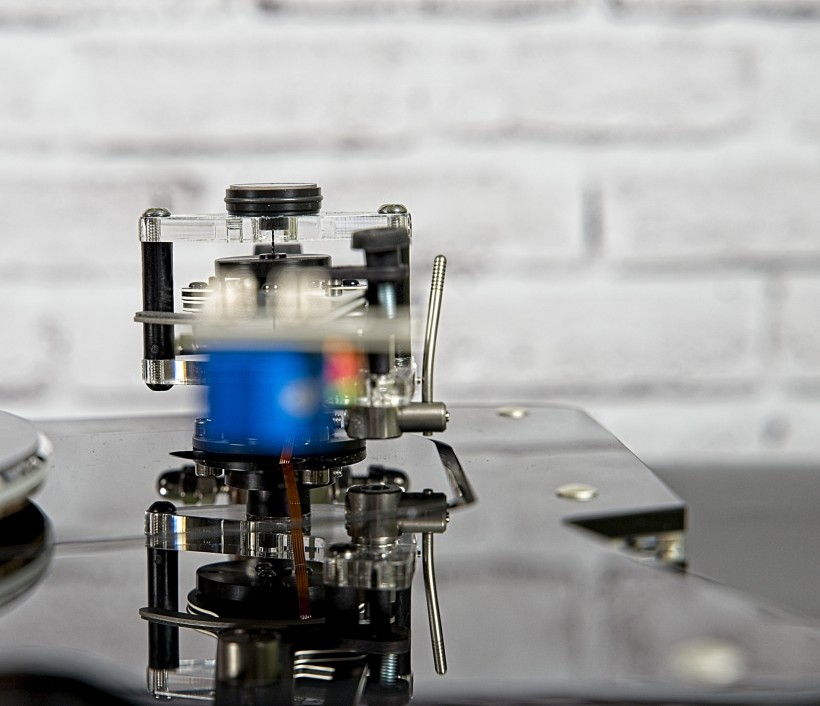
The generator utilizes a Samarium-Cobalt magnet with a cross coil made of pure copper wires. The aluminum tube cantilever supports a micro-elliptical bonded diamond stylus tip. It provides a wide band frequency response of below 10Hz to 40kHz. The cartridge weighs 9,1g and its make and finish (the enchanting blue color!) are stunning.
Vertere’s lineup includes currently only one phono stage named Phono-1 in the MkII version. It supports both, MM and MC cartridges. It’s a relatively small and lightweight (2kg) unit measuring 210 x 235 x 55mm but don’t let the size full you. A small metal chassis with an acrylic front featuring a single toggle switch doesn’t look like much. Yet it is a versatile device that, as it turned out later, is fully capable of letting the Mystic MC, an almost 3,5 kEUR highly capable cartridge, truly shine.
The rear panel looks almost as simple as the front one – one RCA input, one output, to ground posts (one for signal, other for chassis), standard EIC power inlet, power switch, and a three-stage grounding switch. When Position 1 is chosen the signal grounding is connected to the grounding of the chassis. With Position 2 the signal has no contact with the chassis ground, and in Position 3 a 100 ohm series resistor is active between the signal grounding and chassis grounding. These three ground options may just save your life, or rather the joy of listening to the music without any interference caused by ground issues.
Since we are dealing with a small and relatively inexpensive phono stage we can’t hope for a super-convenience of switching adjustments using a touch screen, push buttons, or even a remote control. Instead, underneath the chassis we find a more traditional solution, namely three DIP switch banks. They allow us to fine-tune the gain factor in numerous stages between about 45 and 61 dB and the loading impedance between 78 and 1450 ohms. It means that we should be able to adjust the setting for optimal performance for almost any MC but also MM cartridge as the 47 kΩ loading for MM, and high output MCs is available. Additionally, one can also adjust capacitance for the best performance. Helpfully, the settings are printed on the chassis next to the DIP switches so you don’t have to study the manual for them. The device is available in several finishes matching including one that I particularly like, namely Signature Vertere Orange. The reviewed unit featured a black front though.
Sound
We agreed with Hari, who provided all the components for this test, that I would try out the cartridge and phonostage in my setup first, and then move on to the complete Vertere package including also the DG-1S record player and all the accessories that come with it. And so I did. First, right after testing Aavik R-280 phonostage, I hooked up the Vertere Phono-1 Mk II. And just so we are clear – the Danish phono stage is more than 5 times more expensive, so these two probably won’t be direct competitors in any situation.
The one by Touraj Moghaddam belongs to a rather affordable (although not cheap) bunch at 1748 EUR. Yet, as I was assured by the designer when we met in Munich, it punches way beyond the level suggested by the price tag. You can find another clue in the company’s lineup – despite offering more expensive turntables and tonearms Vertere proposes only this one phono preamplifier model so either they can’t come up with a better one, which seems unlikely, or it is that good.
After listening to it in my system I am not going to claim that it offers quite the same level as Aavik or LampizatOr VP4 Silver, or Doshi Audio Evolution Phono Preamplifier that I tested shortly before Vertere. In comparison to this way more expensive bunch it doesn’t quite reach the same level of precision, resolution, and transparency, or the energy level that the Danish, Polish, and American counterparts impressed me with. Yet, at its price level, it turns out to be as much of a „hidden gem” as my own similarly priced ESE Lab Nibiru, offering way, way better performance than one expects from a less than 2 kEUR device.
The clarity of the sound, the smooth flow of music, the nice extension in both range’s ends – crisp and open highs, punchy and tight bass, the rich, vivid, smooth, palpable midrange, and above all, a realization that came only after a minute or so of listening of how coherent, natural and engaging this presentation seems – all those elements combine into very „friendly”, highly enjoyable sound. My „late” realization is a result of the simple fact, that natural sound is what I expect, hence what I usually notice immediately is its absence, not its presence. Even a short listening session proves that Touraj did not oversell his development at all. It is clear to me now, why the manufacturer and distributor were not hesitant to send it together with a 3,4 kEUR cartridge, and 4,4 kEUR turntable.
Next, I install the Vertere Mystic MC cartridge in my J.Sikora KV12 tonearm on J.Sikora Standard Max deck. In my other tonearm, also KV12 but the pricier Max version performs my trusted Air Tight PC3. I go back for now to my own Grandi Note Celio Mk IV phonostage to stay with the „one stranger in the setup at one time” rule that allows me to assess the stranger best. I get sort of the same vibe or core DNA if you will, as I did before from all Vertere products. The cartridge combines refinement and sophistication, the top-tier resolution and clarity of the presentation, with a richness of the midrange, natural flow of music, and high dynamics. It seems to be a bit more energetic and offers an even better punch than the Phono-1 Mk II did (paired with Air Tight) but the comparison is not quite fair as it concerns whole setups, not individual components. I’ll know more when I combine the two in the actually reviewed setup.
Compared to my Air Tight, Mystic MC seems to be a touch less energetic, but at least as resolving, delivering an abundance of fine details precisely read from the groove. At the same time, it seems a bit calmer in the way it delivers music, as if less impetuous. The presentation is vivid, crisp, and well-organized, but also relaxed, and truly, unconditionally immersive. The music has a natural flow to it, smoothness, and there is also exemplary coherence. At first, it seems to me as if the dynamics of this presentation are lower than with PC-3, but after a while, I realize it is not the case. The transition from the quietest to the loudest sounds is very smooth and maybe, just maybe, a touch slower than with the Japanese cartridge, but the dynamic range is equally impressive. By now, I am absolutely sure, that yet another (after the MG-1 review) exciting adventure in an analog world awaits. It’s time to move all-Vertere-in, so to speak.
It’s worth noting, that with my phonostage I couldn’t use the exact settings for Mystic as suggested by the manufacturer. Now, using Phono-1 MkII I follow the instructions to the letter and set 1.45kΩ loading and 430 pF capacitance. The former value is quite unusual for a Moving Coil pickup, even for one with a relatively high internal impedance of 40Ω. After a while, I decide that the sound seems a bit too bright for my taste so I lower the value to 670Ω and it stays so for most of the listening sessions, as it is more to my liking and I notice no negative effects of this setting. The signal from phonostage to my Circle Labs P300 preamplifier runs via Hijiri HCI-20 IC, and to the Circle Labs M200 power amp via Hijiri Kiwami Million IC. The amplifier drives my GrandiNote MACH4 speakers via Soyaton Benchmark speaker cables.
The first album I cue in isn’t a regular „test material”, but I always play several albums just for fun to let the tested component(s) settle in and myself adjust to a somewhat different sound before critical listening. The album is RAZ DWA TRZY’s „Młynarski”. It’s a live, acoustic performance, and with the Vertere package, it sounds very natural and immersive. The music has this smooth flow, a natural softness to it, the vocals are palpable, present, and sound very realistic because the voice is a bit harsh when needed, and silky smooth on other occasions, yet always present, highly expressive, and deeply touching.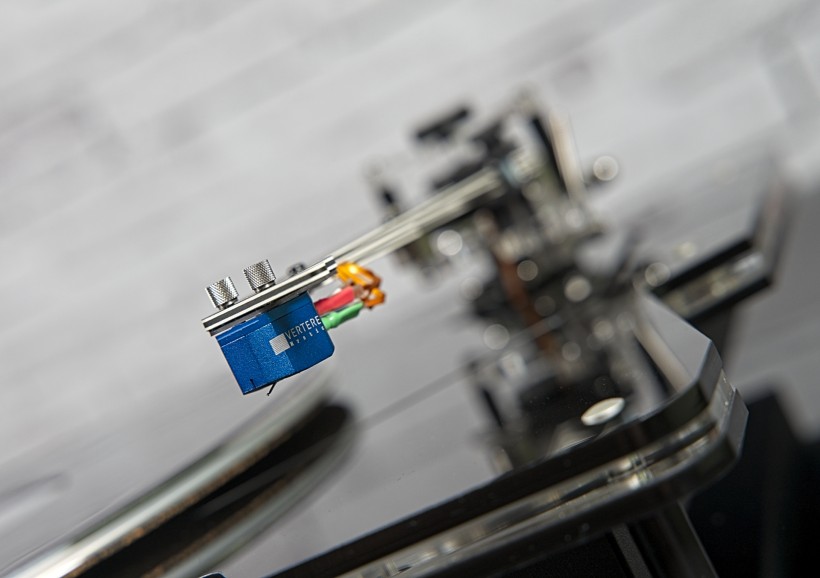
As already said, it is not an audiophile recording so the acoustic cues of the venue are not as well conveyed as in, say, „Jazz at the Pawnshop” I listen to later, but the forefront of the stage is rendered close to me, and its relatively small depth create an impression of witnessing the performance from up close, or from front rows. The sound is warm and deep, and its clarity and transparency are really good as well. I also do notice quite a high level of energy in the performance which is always a great indicator of highly capable components. I always appreciate this feature as it reminds me of my personal reference, the sound/energy of live music. The capability of high energy transfer proves also that the whole concept of the design is right, as very little of the recording’s energy is lost in the process of playback.
Moving on to the famous „Jazz at The Pawnshop” I immediately notice two features that were not as prominent as the previous album. First of all, the soundstage gets real, so to speak. It’s not so much about drawing it with the utmost precision so that I could „read” its precise dimensions, but rather about „feeling” its depth, and of the space (and air) surrounding musicians that is much larger than my room. The placement of individual instruments on the crowded stage is quite precise, and each of them has a 3-dimensional body. As confirmed also later with Muddy Water’s „Live at the Checkerboard Lounge”, even when instruments are placed so close together Vertere’s set allows me to study each of them individually whenever I please. Most of the time, however, I simply enjoy this brilliant performance as a highly enjoyable whole. Even the clattering of cutlery and plates of the people eating their meals during the show doesn’t bother me much – they don’t know how famous this recording will become in the future and how annoyed some fans will be with them.
The Swedish recording though, is mostly about the beautifully rendered space, natural timbre, and energy of each of the instruments. Arne Domnerus’ alto sax and clarinet seem to be present in the room with me and their sound is just real, true to how I remember it from other live performances (not Arne’s, obviously). Lars Erstrand’s vibes in turn are beautifully vibrant, sonorous, and vivid significantly contributing to the credibility of this presentation. There is also so much air filling the space surrounding instruments that they can all breathe easily delivering an open, effortless performance. Plus there is this vibe, this atmosphere of a live performance with musicians having fun, and the audience getting more and more involved by the minute.
I am a huge fan of live music hence the next several albums are also recordings of live events. Such as, for example, Antonio Forcione Quartet’s „In Concert”. The presentation is a bit less focused on the spaciousness of the venue (as the recording doesn’t cover it as quite as well as „Jazz At The Pawnshop”), but more on the high energy of the performance and the skills of talented musicians. I can feel each (almost) visceral string pluck of the bass, or each stick hitting one of the drums and cymbals. Again it is a matter of presenting the band from up close hence making me feel as if I sit just a few rows away from the stage. Funny enough, the rest of the audience seems placed quite far away from me. Yet, I do feel engulfed in the event’s atmosphere, in the pure joy of experiencing (almost) live music.
The energy and dynamics are what hit me first, but the natural tone of each instrument, the fast attack and long decay, the smooth flow of music, and the harmonic richness of the sound join soon after contributing to the highly immersive experience. It is also a very resolving sound and an abundance of tiniest details and subtleties is delivered to enrich, and to complete the presentation, making it even more natural, vivid, and credible. It’s not the most pace and rhythm-based music but I already feel that PRAT is yet another advantage of the tested set. The intricate passages on Antonio’s guitar, the fast drumming – it all impresses me with clarity, with how good the differentiation in terms of both, tone and dynamics, is. I can’t help but tap the rhythm and smile while listening to this fantastic album.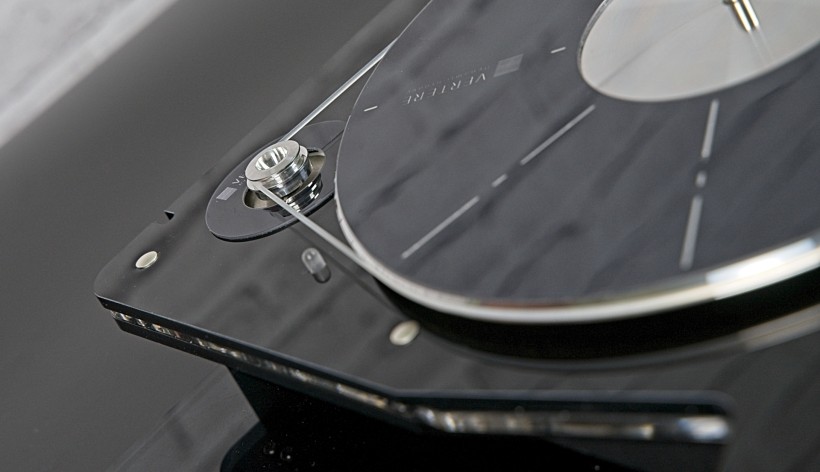
The aforementioned Muddy Water’s album or Al Di Meola’s „Elegant Gypsy”, and even AC/DC’s „Live” serve as a tool to assess the performance of the DG-1S while playing intense, dynamic music based largely on electric guitars. And Vertere does not disappoint. All the qualities already pointed out in acoustic music are there shining again. It is hard to resist the energy of the presentation, the impeccable timing, and the extended bass that may not be as visceral as with my JSikora/AirTight set, but doesn’t give me any reason for complaint either as it is almost as authoritative.
The midrange, so important when it comes to electric guitars and vocals, is rich, and dense, yet open and pure. The bass is tight and taut, fast, and punchy. The treble is vibrant, open, as aggressive and harsh as needed for rock music, yet not enough to become an issue. Even some brightness and graininess often present on rock albums are presented in a way that doesn’t spoil the fun of listening to technically imperfect, yet musically brilliant (at least for me) tracks. Each of these albums is really fun to listen to, and while some imperfections are clear as Vertere set does not try to hide them, I can still admire the mad skills of Muddy, Al, or Angus playing my favorite instrument with my fingers traveling an imaginary fretboard without me even knowing about it. That’s what I expect from any rock or blues album, and that’s what the tested set provided in spades.
A totally different album follows all that blues/rock fun, namely Michel Godard’s „Soyeusement ● Live in Noirlac”. It’s a brilliant piece of music inspired by that by Monteverdi played using a mix of period and contemporary instruments and recorded in an old Noirlac Abbey directly into two tracks. Vertere’s set conveys both, the incredibly well captured huge space of the venue and the timbres of all these various instruments. Despite being an „entry-level” turntable it shows an ability to effortlessly resolve all those tiny details and subtleties, all the acoustic cues, that contribute to a convincing rendition of this amazing spectacle. It is able to place, when needed, some instruments a dozen or more meters away from me and show the reverb even deeper in the huge stage. It is impressive how much information Vertere DG-1S delivers despite the instrument being placed so far away.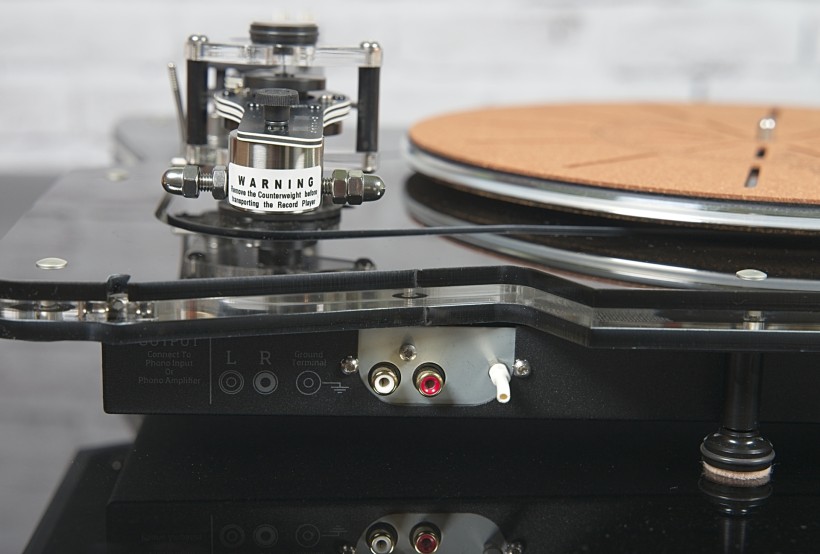
To top my listening sessions off I cue in a „super-classic” or Miles Davis’ „Kind of Blue” and … it’s clear immediately that Vertere DG-1S is a real charmer. It puts a spell on the listeners, draws them in into the slowly developing music story, and deeply involves them emotionally. The way the tested record player plays this album reminds me a bit more of suspended decks than unsuspended ones, such as Vertere DS-1S. There is this natural softness to the sound, the velvety smoothness of the music’s flow, but also, when needed, a touch of aggressiveness or harshness in Miles’ trumpet that makes it so real, so „here and now”. Hearing that, I find myself on the edge of the chair sitting up so as not to miss a single note of his performance as if I am listening to it for the first time. It’s an exciting experience that doesn’t happen that often, and it indicates that this is a really well-put-together set that, while (relatively) reasonably priced has a lot to offer.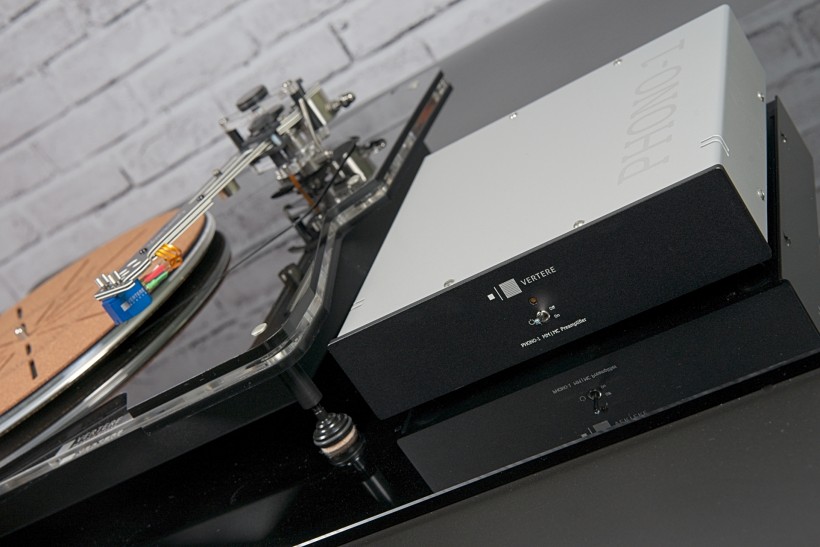
Summary
I know that in most cases users of the Vertere DG-1S will use one of the Vertere’s own MM cartridges, as offered in two of three packages, or maybe some other pickup most likely costing less than Mystic MC. Yet, using the latter I could explore the full potential of the deck and tonearm and I have to admit it is impressive. The entry-level Vertere offers a performance that some brands’ top achievements couldn’t match. Yet instead of listing all the qualities again let me just say that it is incredibly musical and offers a highly immersive performance that encourages spending as much time listening to the music as possible. While doing that, it also ensures that you will hear all the details and subtleties the stylus reads from the groove presented as a beautifully coherent, rich, natural-sounding whole. Whether you want to start your vinyl records adventure from a high but not super-expensive model or you’re looking for a significant upgrade compared to dozens of popular turntable decks available on the market, Vertere DG-1S may be exactly what you’re looking for.
Prices (when reviewed US Listing!):
- Vertere DG-1s: 4.148,00 EUR w/o tonearm
- Vertere DG-1s: 4.448,00 EUR with Groove Runner tonearm
- Vertere Phono One MkII: 1.748,00 EUR
- Vertere Mystic MC: 3.448,00 EUR
- Vertere REDLINE Phono Cable: 848,00 EUR / 1,15 m
- Vertere REDLINE Power Cable: 858,00 EUR / 2m
Manufacturer: VERTERE ACOUSTICS
Technical specifications (according to the manufacturer):
DG-1S Turntable
- Type: Belt drive
- Motor: 24 Pole Synchronous; Acetal Spindle Thrust Bearing
- Motor Mount: Axially De-coupled
- Pulley: Super Precision Aluminum Alloy
- Drive Belt: Bespoke Silicone Rubber
- Platter DG-1: Precision Machined Aluminum Alloy; PETG Bonded Record Interface Mat; Underside Bonded Resonance Control Disc and Bonded Protective Cork/Neoprene/Nitrile Disc
- Bearing Spindle DG-1: Non-Magnetic Stainless Steel Super Precision Machined and Polished
- Roundness / Concentricity: < 5 Microns
- Bearing Housing: Brass; Super Precision Machined; Bore Tolerance < 5 Microns; Super Precision Tungsten Carbide Ball
- Plinth Structure: 3 Layer Cast Acrylic; Middle Clear Plinth, Internally Illuminated
- Isolation System: 6 Point, Bespoke Silicone Rubber
- Support Structure: Black Coated Zintec Steel Chassis; Three Adjustable Feet with Resistive Felt
- Motor Drive: Advanced Microprocessor Controlled; Fully Programmable with Motor Noise Reduction; Bridged Balanced Motor; Output Amplifiers
- Speeds: 33.3 and 45 rpm (+/- 0.2%); Electronically Selectable
- Dust Cover: Bespoke Formed Tinted Polycarbonate
- Dimensions (W x D x H): 457 x 381 x 127 mm (including dust cover)
- Power Supply: Wall Adaptor Type; UK, US, EU, and AUS Exchangeable Plugs; 100 – 240 Vac with 1.5m Cord
- Finishes: Black and white gloss
- Weight: 7,7 kg netto
Groove Runner Tonearm
- Type: Fixed Axis Bearing
- Effective Length: 9″
- Overhang: 17.5mm
- Offset Angle: 22.9°
- Bearing Structure: One Twisted Nylon 6.6/6 Thread – Horizontal Motion; Two High Strength Kevlar Threads – Vertical Motion
- Counterweight: Stainless Steel With Fine Azimuth Adjustable Screw
- Front Beam Small Weight: Stainless Steel Block; Fine Tracking Weight and Arm/Cartridge Resonance Tuning
- Internal Wiring: Gold Plated Flexible PCB with Vertere Gold Plated Cartridge Tags; One Piece from Cartridge To Output; RCA Sockets
- Weight: 310g
Mystic MC cartridge
- Type: Moving Coil Phono Cartridge
- Mounting: M2.5 Threaded Holes; Special Tri-Point Contact
- Output Level: 0.5mV
- Frequency Response: 10 Hz -40 kHz
- Coil Impedance (per Channel): 40Ω
- Recommended Load: 680 Ω – 1k5 Ω; 220pF – 470 pF
- Channel Balance: Better than 1.0 dB
- Recommended Tracking Weight: 2.0g
- Cantilever: Aluminum Tube
- Stylus: Micro Elliptical Diamond
- Weight: 9.1g
Phono One MkII
- Type: MC/MM Preamplifier Main Phono Circuit on Separate Gold-Plated PCB
- Power Supply: Linear, Int. Switchable Transformer on Separate Gold-Plated PCB
- Gain Settings: 40.2dB to 62.8dB In 12 Steps; High Gain version – Add 6.4dB to all settings
- Input Impedance Settings: 47k for MM; 78R to 47K for MC – in 14 Steps
- Capacitance: 100pF & 470pF for MM, 100pF to 1.02uF for MC – In 9 Steps
- Frequency Response: 20Hz – 20kHz
- Noise: +/- 0.2dB; < -78dB – AWD
- THD-N: 0.03%
- Finish Front Panel Options: Vertere Orange, Silver, Black
- Dimensions W x D x H (Incl. Switches & Feet): 210 x 235 x 55mm
- Weight: 2 kg
Associated equipment:
- Digital source: a custom passive server with WIN10, Roon, Fidelizer Pro 7.10, JCAT NET XE, and JCAT USB XE cards with FERRUM HYPSOS Signature power supply, KECES P8 (mono) linear power supply for the server, JCAT USB Isolator
- D/A Converter: LampizatOr Pacific 2 +Ideon Audio 3R Master Time (USB signal regenerator)
- Analog front end: J.Sikora Standard MAX turntable, J.Sikora KV12 tonearm, J.Sikora KV12 MAX tonearm, AirTight PC-3, phono stages: Grandinote Celio MK IV, ESE Lab Nibiru V 5.
- Power amplifiers: GrandiNote Shinai, Circle Labs M200, Art Audio Symphony II (modified)
- Preamplifier: Circle Labs P300
- Loudspeakers: GrandiNote MACH4, Ubiq Audio Model ONE Duelund Edition.
- Interconnects: Bastanis Imperial x2, Soyaton Benchmark, Hijiri Million, Hijiri HCI-20, TelluriumQ Ultra Black, KBL Sound Himalaya II XLR, David Laboga Expression Emerald USB, David Laboga Digital Sound Wave Sapphire Ethernet
- Speaker cables: Soyaton Benchmark
- Power cables: LessLoss DFPC Signature, Gigawatt LC-3
- Power: Gigawatt PF-2 MK2 and Gigawatt PC-3 SE Evo+; a custom power line with Gigawatt LC-Y in-wall cable; Gigawatt G-044 Schuko and Furutech FT-SWS-D (R)
- Network: Silent Angel Bonn N8 + Silent Angel Forester F1 + optical LAN isolator
- Racks: Base VI, Rogoz Audio 3RP3/BBS
- Anti-vibration accessories: ROGOZ-AUDIO SMO40 and CPPB16 platforms and ROGOZ AUDIO BW40MKII feet, Franc Accessories Ceramic Disc Slim Feet and Wood Block Platform, Graphite Audio CIS-35 and IC-35


